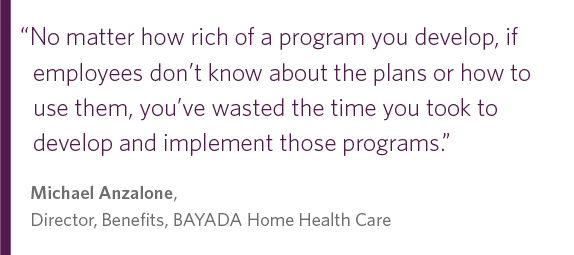
If you don’t own the communications you can’t own the employee experience

What’s ailing your new program?
You anted up some serious coin for a new program. You prevailed in budget battles. You created countless versions of spreadsheets to prove the program’s ROI to leadership. Not to mention all of the endless meetings and early mornings (that stretched into late nights) putting the finishing touches on every last detail. Your program’s administrator even included launch communications in their price. Sounds like a recipe for success, right?
We see this happen a lot. You’re working day and night to get a new program off the ground. Focusing on building it, so they’ll come. You know you need to communicate about it, but communication is not your thing, so when your program administrator says, “Communication is included,” you say, “Hooray—because who’s got time for that?”
It’s tempting to take the path of least resistance—and cost—and let your program vendors handle the communication for new program launches. But unless it is fully aligned with your brand and your overall strategy, that standard communication (which is typically included in the implementation fees) could end up hurting your engagement down the road. Yes, you might have a few early adopters. But months after a program launch, we often hear from clients that the majority of their employees seem unaware and uninterested in the new program.
Why? Perhaps the standard campaign just wasn’t enough horsepower to get your new program off the ground, let alone make the program stick with employees. Or maybe employees didn’t fully recognize or connect with your vendor’s communication. Even though it was cobranded with your logo, it may not have fully reflected your style, brand, tone, or voice—all the things that your employees connect with.
When your communication is inconsistent with your brand and doesn’t reflect your employee value proposition and broader goals, employees don’t recognize it as yours. It can even feel like a sales pitch. Worst of all, some employees might not realize that it’s a program being offered by your company for their benefit, and they trash it as junk. In a recent employee survey, one of our clients received clear feedback from employees on this topic: “Stop selling to me with sales materials from the vendor,” and “You guys keep pushing these third-party services on us.”
That’s a far cry from the experience you want to create, which is to show employees the love with that amazing new benefit you just implemented that just so happens to also be designed to improve their life.
So, what’s the best way to get the word out? How do you reach employees so they’re empowered, informed, and ready to take action?
Leverage the launch
On a current project to launch a suite of new online resources and mobile apps, our client brilliantly summed up the importance of strategic launch communications: “We have one chance to get this launch right.” That meant putting a lot of thought into the planning, including layering custom communication over the pre-packaged vendor pieces to create a rich, cohesive campaign. Here’s how:
- We mapped the end-to-end experience. This meant examining every touchpoint through the lens of how employees and their families will experience these new resources—from registering at vendors’ websites to downloading apps—to identify where employees might get stuck, frustrated, or confused.
- We put the employer brand front and center. We had quality materials from the individual vendors to use, and we tied them together with the employer brand so that they are recognizable and cohesive.
- We went channel surfing. Working with multiple vendors to identify opportunities across their various platforms (from auto-generated emails to interactive voice response (IVR) and call center scripts) to reinforce and align messaging with the employee value proposition and broader organizational goals.
- We focused on the audience. Communication was framed around what’s most important to employees (hint: themselves and their families), and it showed them how these tools could make it more convenient to manage health alongside their busy lives.
- We made it real. The communications illustrated how these new tools fit in with the bigger picture and why they should care.
And all this extra planning effort didn’t bust the budget! Many of the enhancements we uncovered during the experience mapping exercise involved only minor tweaks to the vendors’ existing launch and ongoing communications.
The result: All launch communication is cobranded with both the vendor’s and organization’s logo. However, most pieces reflect the organization’s benefits brand—so employees and their families can easily connect the dots. As of the date of this posting, the first campaign piece has been mailed, and after just a few days this thoughtful approach is already paying off with a higher-than-expected registration rate. We’re confident that we’ll continue to see spectacular results. (Stay tuned for a future case study!)

Your benefits can be the cornerstone of creating an unforgettable employee experience. A new program launch is a critical opportunity to show their value. After all, they’re there for the good times (having a baby) and the bad (managing serious health, financial, or emotional problems).
Communicating your programs in a way that’s connected to your strategy as an organization— framed around what’s most important to employees (hint: themselves and their families), with a clear ROI for participating—will not only boost program participation, it will also buy you something equally valuable: recognition that you truly care about your employees and offer meaningful programs to support their lives.
Need help owning your employee experience or improving the effectiveness of your communications? Let’s talk.
Work with Us
We partner with organizations that value their people first. Let’s talk.

Rita Harris, VP Senior Consultant, is known for her ability to break down complex benefits programs into their essential parts, so employees can quickly assess “what’s in it for me.”
